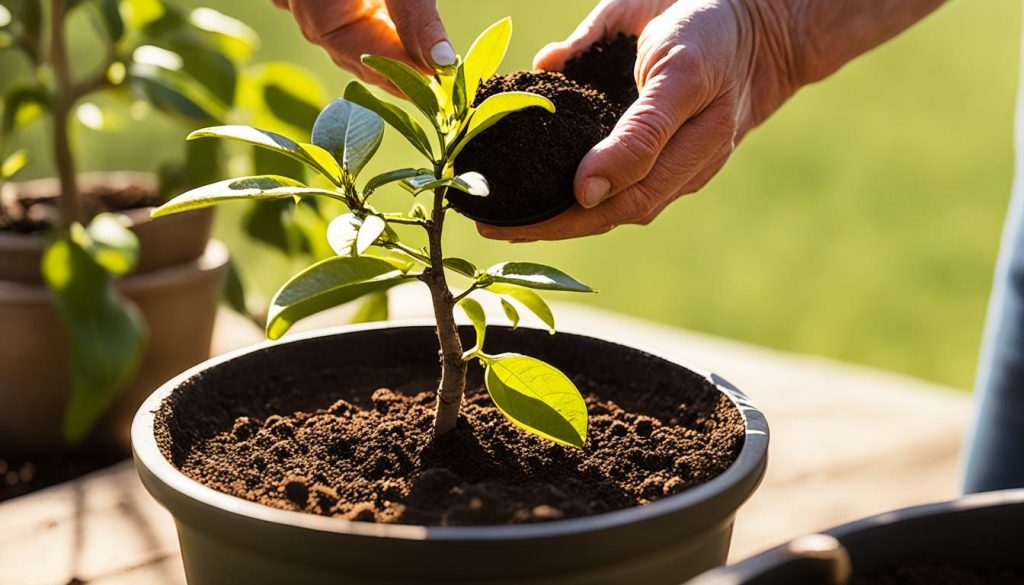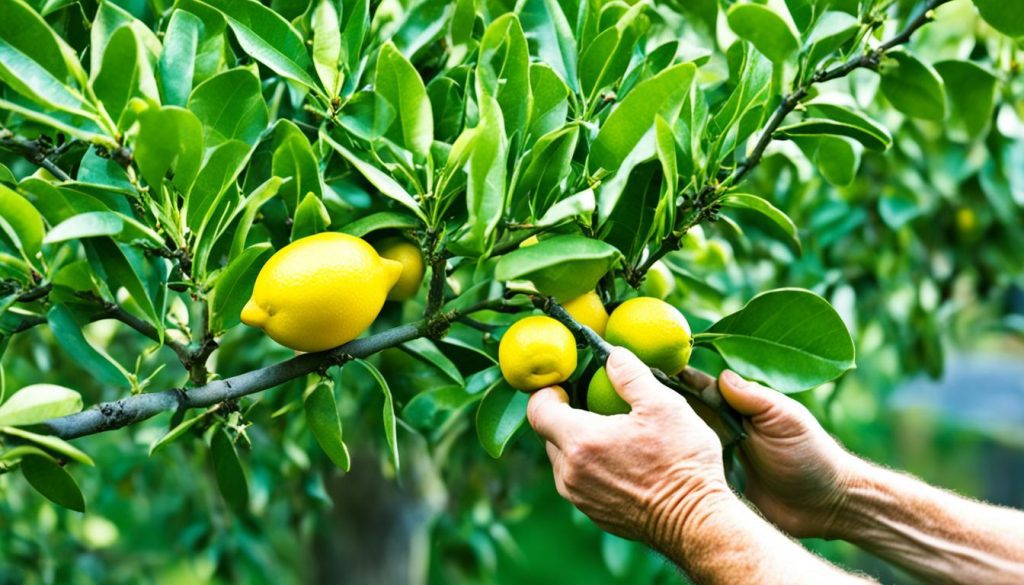Growing a lemon tree can be a rewarding and fulfilling experience. Whether you want to enjoy the beauty and fragrance of the tree or harvest your own fresh lemons, the process is simpler than you might think. In this comprehensive guide, I will walk you through the step-by-step process of growing a lemon tree from seed and provide essential tips for its care and maintenance.
How to Grow a Lemon Tree
- Choose the right lemon variety for your preferences and growing conditions.
- Plant lemon seeds in well-draining soil and provide them with adequate sunlight and warmth.
- Transplant seedlings to larger containers once they have developed a few sets of leaves.
- Maintain proper care practices, including regular watering, pruning, fertilization, and pest control.
- Consider growing lemon trees indoors for year-round enjoyment.
Selecting the Right Lemon to Grow
When growing a lemon tree from seed, choosing the right type of lemon is crucial for successful cultivation. As you embark on your lemon-growing journey, it’s important to select lemons with a full, mature appearance and free of blemishes or cuts. The quality of the lemon you choose will significantly impact the growth and flavor of your lemon tree.
There are several lemon tree varieties available, each with its own unique characteristics and flavors. Some popular lemon varieties include Eureka lemons, Lisbon lemons, and Meyer lemons. When selecting a lemon for growing, consider your preferences in terms of taste and tree characteristics.
Eureka lemons are the most common variety, known for their juicy, acidic flavor. They are typically easy to grow and produce abundant fruit. Lisbon lemons are similar to Eureka lemons but have thinner skin and sweeter juice. Meyer lemons, on the other hand, have a sweeter and less acidic taste, making them perfect for culinary use.
Keep in mind that lemon seedlings grown from seeds may exhibit variations in growth habits, colors, and flavors compared to their parent trees. This adds an element of excitement and surprise to the growing process, allowing you to explore different traits and flavors as your lemon tree matures.
Remember, selecting the right lemon for growing ensures a rewarding experience and a thriving lemon tree. Now that you’ve learned about the different varieties available, you can choose the perfect lemon to embark on your lemon-growing journey!
Planting Lemon Seeds
Once you have selected the type of lemon you want to grow, you can start the process of planting lemon seeds. Follow these steps to successfully grow a lemon tree from seed.
Carefully Remove and Prepare the Seeds
To begin, carefully remove the seeds from the lemon fruit, making sure not to damage them. Place the seeds in a cup of water to rinse them and remove any pulp or residue. After rinsing, dry the seeds thoroughly before planting.
Choose the Right Soil and Containers
Fill seed trays or small plastic pots with a well-draining potting soil mix. The soil should provide good drainage to prevent waterlogging, as excess moisture can hinder seed germination and growth. Plant one lemon seed in each hole, burying them in the soil at a depth of about half an inch.
Provide Optimal Growing Conditions
After planting the seeds, it’s important to create the right environment for germination. Keep the soil moist by watering gently, ensuring it doesn’t dry out. Place the planted seeds in a warm, well-lit location, such as a sunny window sill or under a grow light. This will help facilitate proper germination and seedling growth.

By following these steps and providing the necessary care and maintenance, you can successfully grow lemon trees from seeds. Planting lemon seeds is an exciting and rewarding process that allows you to witness the growth and development of your own lemon tree.
Caring for Lemon Seedlings
Once your lemon seedlings have produced their third set of leaves, it’s time to give them some extra care and attention. Transplanting them into larger containers will allow their roots to expand and establish a strong foundation for growth.
To begin, carefully remove each seedling from its original pot, ensuring not to damage the delicate roots. Gently loosen the soil around the roots to promote healthy growth.
Choose a larger container that provides ample space for the roots to spread out. It’s important to choose a container with adequate drainage to prevent waterlogged soil.
When it comes to where to keep your lemon seedlings, you have two options. If you have a suitable indoor growing environment, such as a greenhouse or a well-lit room, you can keep them indoors under grow lights. Alternatively, you can place them outdoors in full sun. Just make sure to protect them from extreme weather conditions, like strong winds or frost.
Lemon trees thrive in well-draining soil, so consider using a fast-draining cactus and succulent mix. If you’re using regular potting soil, you can enhance drainage by adding perlite or small rocks to the mix.
Watering your seedlings deeply is crucial for their healthy development. Make sure the soil is thoroughly moistened, but avoid overwatering, as excessive moisture can lead to root rot.
Lastly, as with any plant, lemon seedlings can be susceptible to pests and diseases. If needed, you can use organic pesticides to protect your seedlings from common pests like aphids or mealybugs.
Maintaining a Healthy Lemon Tree
To maintain a healthy lemon tree, it’s important to follow proper maintenance practices. By regularly caring for your lemon tree, you can ensure its long-term health and productivity. Here are some essential tips for lemon tree maintenance:
1. Pruning
Regular pruning is essential for a healthy lemon tree. Prune the tree to remove dead or diseased branches, as well as any crossing or crowded branches. This will improve air circulation and promote better fruit production. Use clean and sharp pruning shears to make clean cuts without damaging the tree.
2. Fertilization
Fertilizing your lemon tree is crucial for providing the essential nutrients it needs to thrive. Use a balanced citrus fertilizer specifically formulated for lemon trees. Follow the instructions on the fertilizer package to ensure proper application. Apply the fertilizer during the growing season, typically in early spring and again in late summer.
3. Watering
Proper watering is vital for maintaining a healthy lemon tree. Water deeply and thoroughly, allowing the soil to become moist but not waterlogged. Avoid overwatering, as excessive moisture can lead to root rot. Monitor the moisture levels in the soil and adjust your watering schedule accordingly, taking into account weather conditions and the specific needs of your lemon tree.
4. Disease Prevention
Lemon trees are susceptible to various pests and diseases such as mealybugs, aphids, and scale insects. Regularly inspect your tree for any signs of infestation or disease. If you notice any issues, take immediate action to prevent the spread and manage the problem. Consider using organic pest control methods or consult with a professional if necessary.
5. Pests Management
Along with disease prevention, effective pest management is crucial for the health of your lemon tree. Monitor your tree regularly for signs of pests and take appropriate measures to control them. This can include using natural predators, like ladybugs, or organic pest control methods such as neem oil or insecticidal soap.

By following these maintenance practices, such as regular pruning, proper fertilization, appropriate watering, disease prevention, and pests management, you can ensure the health and productivity of your lemon tree. With a little care and attention, your lemon tree will thrive and reward you with abundant harvests of delicious and fragrant lemons.
Growing Lemon Trees Indoors
Did you know that you can grow lemon trees indoors and enjoy fresh lemons throughout the year? Indoor lemon tree care requires proper attention to sunlight and temperature conditions.
Place your lemon tree near a south-facing window to ensure it receives at least 6 to 8 hours of direct sunlight daily. Sunlight is essential for the tree’s growth and fruit production. If natural sunlight is limited in your indoor space, you can use grow lights to supplement the light requirements. This will help your lemon tree thrive even in areas with low natural light.
Maintaining the right temperature is also crucial for indoor lemon trees. Keep the temperature within the range of 55 to 68°F (13-20°C) for optimal growth. Avoid exposing the tree to extreme temperature fluctuations, as it can adversely affect its health.
Just like outdoor lemon trees, indoor lemon trees require regular care and maintenance. Remember to water your lemon tree consistently while avoiding overwatering. Allow the soil to dry slightly between waterings, and ensure proper drainage to prevent root rot.
Indoor Lemon Tree Care Tips:
- Place the lemon tree near a south-facing window for sufficient sunlight or use grow lights as a supplement.
- Maintain a temperature range of 55 to 68°F (13-20°C) for optimal growth.
- Water the tree consistently, allowing the soil to dry slightly between waterings.
- Ensure proper drainage to prevent root rot.
- Regularly inspect the tree for pests and diseases and take appropriate measures for pest control.
- Prune the tree to maintain its shape and remove any dead or damaged branches.
By following these indoor lemon tree care tips, you can successfully grow a healthy lemon tree indoors and enjoy the beauty and flavor of fresh lemons all year round.
Conclusion
Growing a lemon tree can be a fulfilling and delightful experience. By following the step-by-step guide and implementing the care and maintenance tips provided, you can successfully cultivate a lemon tree from seed and savor the beauty and flavor of fresh lemons. Whether you decide to nurture a lemon tree indoors or outdoors, proper selection of the lemon variety, meticulous planting, and regular care will ensure the vitality and productivity of your tree. Experiment with different techniques and varieties to discover what suits you best, and relish the journey of cultivating your very own lemon tree.
FAQ
How do I select the right lemon to grow?
Look for lemons at the market that have a full, mature appearance and are free of blemishes or cuts. Choose from varieties such as Eureka lemons, Lisbon lemons, and Meyer lemons, based on your preferences.
How do I plant lemon seeds?
Carefully remove the seeds from a lemon and rinse them in water. Dry the seeds before planting them in well-draining soil mix, and keep the planted seeds in a warm, well-lit location.
How do I care for lemon seedlings?
After the seedlings produce their third set of leaves, transplant them into larger containers. Provide well-draining soil, regular watering, and protection against pests and diseases.
How do I maintain a healthy lemon tree?
Regularly prune the tree to remove dead or diseased branches, fertilize it with a balanced citrus fertilizer during the growing season, water it deeply but avoid overwatering, and monitor for pests and diseases.
Can I grow lemon trees indoors?
Yes, place the tree near a south-facing window for at least 6 to 8 hours of direct sunlight daily. Maintain a temperature range of 55 to 68°F (13-20°C) and follow the same care and maintenance practices as outdoor lemon trees.
How do I grow a lemon tree from seed?
Follow the step-by-step guide provided in this article, including selecting the right lemon, planting the seeds, caring for the seedlings, maintaining the tree’s health, and optionally growing it indoors.




